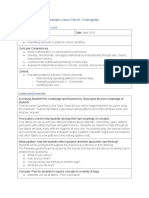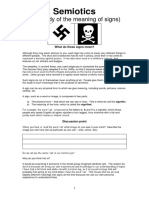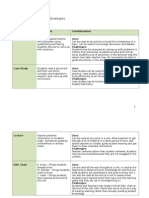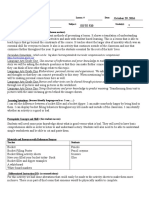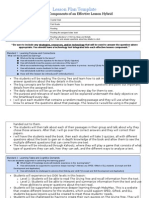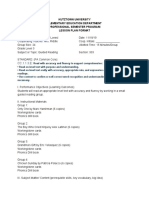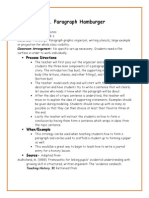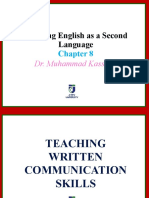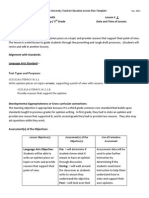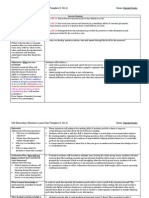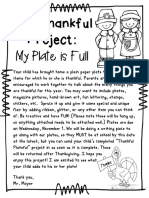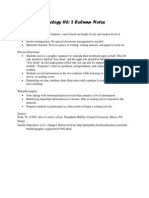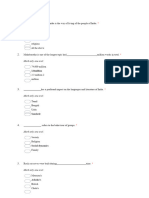Questioning
Questioning
Uploaded by
api-266292540Copyright:
Available Formats
Questioning
Questioning
Uploaded by
api-266292540Original Title
Copyright
Available Formats
Share this document
Did you find this document useful?
Is this content inappropriate?
Copyright:
Available Formats
Questioning
Questioning
Uploaded by
api-266292540Copyright:
Available Formats
Strategy #21: Picture Walk
Basics:
Time Needed: 10-15 minutes.
Room Arrangement: For younger grades, a carpet arrangement. Other grades, at their
desk will work.
Materials Needed: picture book to model the activity, student picture books.
Process Directions:
The teacher asks students to select a book from the classroom library and find a partner.
The teacher models a picture walk by saying the following:
o Let's look at the front cover. What do you think this story is about?
o Do you have any experience with ________? An experience I had was...
o Turn the page. What do you see? What do you think is happening?
o What do you think will happen next?
o Here we are almost at the end of the book. How will the story end?
o What are you curious to know more about in the story? I wonder if...
In pairs, students conduct their picture walk to each other, just as the teacher modeled.
Each student will be given 5 minutes to complete the picture walk for their book.
When/Examples:
The activity should be used when students are engaging in reading narrative and
expository texts.
Source:
Clay, M.M. (1991). Introducing a new storybook to young readers. The Reading Teacher,
45, 264-273
Strategy #22: KWL
Basics:
Time needed: 10-20 minutes
Room Arrangement: No special arrangement needed.
Materials needed: KWL sheets for each student and projected chart for teacher use.
Process Directions:
The teacher explains what each letter means to the class.
o K = What I Know
o W = What I Want To Know
o L = What I Have Learned
The class brainstorms and discusses what they know about the subject or content before
the lesson.
The teacher writes the students responses in the K section of the projected KWL chart.
The students will write all responses on their personal KWL sheets.
The class then brainstorms and discusses any questions or clarifications they have about
the content or subject.
The teacher writes the students responses in the W section and the students do the same.
The teacher will then use the students questions and find ways to answer them
throughout the current and future lessons.
The lesson is then taught with answers to as many student questions as possible based on
the lesson objectives.
After the lesson, the class brainstorms and discusses what they have learned.
The teacher will write the students responses in the L section and students will do the
same.
When/Examples:
This can be used with any subject area lesson.
It allows students to build on their previous knowledge.
Source:
Ogle, D. S. (1986). K-W-L group instructional strategy. In A. S. Palincsar, D. S. Ogle, B. F.
Jones, & E. G. Carr (Eds.), Teaching reading as thinking (Teleconference Resource
Guide, p. 11-17). Alexandria, VA: Association for Supervision and Curriculum
Development
Image:
Lanley, J. (2011). [Image]. Retrieved from http://notebookingfairy.com/2011/03/k-w-l-graphicorganizer-printable/
(Lanley, 2011)
Strategy #23: SQ3R
Basics:
Time Needed: 10-20 minutes
Room Arrangement: Students can work independently or in groups, so the either at their
desk or in pairs around the room.
Materials Needed: a piece of literature, papers, and a pencil.
Process Directions:
The teacher assigns students, either in pairs or individually, a subsection from their
textbook.
Survey: After students have their piece of literature, they look through the pages and do a
picture walk (see strategy 21) on their own, looking at titles, headings, charts, and
illustrations. Once this is done, they read the first and last paragraph to help build their
knowledge of what the lesson and reading will be about.
Question: Students then look at the headings and bolded vocabulary words coming up
with comprehension questions that they will answer as they read.
Read: Students read the passage, searching for the answers to their questions and writing
those answers down. The students use context clues for unfamiliar words and unclear
passages. As they read, the students may create more questions that will be brought up in
further discussion.
Recite: Students close the book and recall what they have read. This can be done
individually, in small groups, or as a whole class.
Review: Once they have completed the reading section, students check their answers with
another student. If there are discrepancies, students go back and reread to find the correct
answer. After this, have the students write a summary of the reading.
When/Examples:
This strategy is used before, during, and after reading.
This can be used when in social studies class when discussing a specific period of time or
a major historical event.
Source:
Robinson, F. P. (1961). Effective Study. New York: Harper.
Image:
Scott, J. (n.d.). [Image]. Retrieved from http://www.teacherspayteachers.com/Product/An-ECInclusion-Teachers-version-of-SQ3R-Poster-695631
(Scott, n.d.)
Strategy #24: Think, Pair, Share
Basics:
Time Needed: 5-10 minutes
Room Arrangement: Students should be sitting by a partner to share their ideas with.
Materials Needed: None.
Process Directions:
The teacher presents a question or idea.
The teacher gives students about 30 seconds to think about the question or idea.
Then the teacher tells the students to turn to a partner and share what they thought about.
For about a minute, the pairs their answers.
Then they share out with the whole group..
When/Examples:
This activity would work well for a group that enjoys interpersonal interaction.
This would be an effective anticipatory set and could also be used at the end of a lesson
to review what was learned.
Sources:
Lyman, F. (1981). The responsive classroom discussion: The inclusion of all
students. Mainstreaming Digest. University of Maryland, College Park, MD.
Strategy #25: Questions to the Teacher
Basics
Time Needed: 10-15 minutes, plus a break in between for the teacher to read the
questions
Room Arrangement: No special arrangement needed.
Materials Needed: Mailbox on the teachers desk, piece of paper, text, and writing utensil
Process Directions:
The students read a section of text (fiction or nonfiction, a paragraph to a chapter).
After students read the text, they compose a question about what they read.
They write it on a piece of paper and put it in the mailbox on the teachers desk.
Sometime during the day (lunch, recess, or specials), the teacher reads through the
questions and sorts them according to three levels of understanding:
o Type I: Questions seek to understand information from the reading.
o Type II: Questions cause the reader to analyze, critically examine, and appraise
the information presented by recognizing what is missing or only implied.
o Type III: Questions judge the author's position or formulate an alternativeor
even contraryhypothesis
Once the teacher has the questions sorted, he or she can discuss the questions with the
students, using examples of higher tiered thinking to encourage deeper thinking.
When/Examples:
This strategy would be effective for reading expository texts.
It would work well for social studies and science.
Source:
Lewin, L. (2010). Teaching critical reading with questioning strategies. Educational
Leadership 67 (6).
Strategy #26: Ranking Ladder
Basics:
Time Needed: 15 minutes
Room Arrangement: No special arrangement needed.
Materials Needed: Ranking Ladder sheets, writing utensil
Process Directions:
The teacher passes out Ranking Ladder image sheets to the students or has them draw
their own.
The teacher asks the students a question pertaining to the importance of what they have
learned in the lesson (What is the most important thing to do when?)
Students rank the steps from least important at the bottom of the ladder to most important
at the top.
Then the teacher pairs students to discuss their steps.
After students discuss in pairs, the class discusses it as a whole group.
When/Examples:
This strategy helps students organize what they already know to help them further
understand the material.
It focuses on what is important in their understanding of the content.
Source:
Bellanca, J. (2007). A guide to graphic organizers second edition. Thousand Oaks, CA: Corwin.
Ranking Ladder
Most
Important
Less
Important
Less
Important
Least
Important
__________________
__________________
__________________
__________________
Strategy #27: Elkonin Boxes
Basics:
Time Needed: 5-10 minutes.
Classroom Arrangement: Usually done in small groups or one-on-one.
Materials Needed: Elkonin box worksheet and pencil or a dry erase board and marker.
Process Directions:
The teacher pronounces the target word slowly so that the student can hear each sound.
Student repeat the word back, making sure that he or she is doing it slowly so that the
sounds can be heard separately.
The teacher gives the student the worksheet or a dry erase board. If a dry erase board is
given, the student draws the boxes that are needed for each syllable or sound.
Have the student write in each phoneme in a separate box.
Direct the student to slide his or her hand along each box as the word is repeated.
When/Example:
Elkonin boxes can be used when a student is struggling spelling or with phonics.
This helps by focusing on individual syllables or sounds.
See sample lesson (Animal Communities) for an adapted version using cut out letters
being slid into the boxes.
Source:
Griffith, P.L. & Olson, M. W. (1992). Phonemic awareness helps beginning readers break the
code. The reading teacher, 45(7), 516-523.
Image:
Learning A-Z. (n.d.). [Image]. Retrieved from http://www.readinga-z.com/book/
decodable.php?id=10
(Learning A-Z, n.d.)
Strategy #28: Pick a Side/Corner
Basics:
Time Needed: 5-10 minutes.
Room Arrangement: Need space on each side or corner of the classroom to stand.
Materials Needed: None.
Process Directions:
The teacher reads a statement with multiple choice answers.
If there are two options (true/false, yes/no, agree/disagree), the teachers prompts the
students to go to a certain side of the classroom based on their answers.
If there are three or four options, the teacher prompts the students to go to a certain corner
of the room based on their answers.
After all of the students have picked a side, the teacher chooses students to share why
they went where they did. The students can be chosen at random or be called on by
choice.
Repeat as many times as necessary.
When/Examples:
This can be used to introduce a subject for a lesson.
This would work well for review at the end of a science or social studies lesson.
It can also be used to gather data about which students are struggling.
Source:
Davaney, E. (2012). Pick a side: Warm up and discussion. Teaching Channel. Retreived
from https://www.teachingchannel.org/videos/quick-classroom-warm-up
Strategy #29: Cubing
Basics:
Time Needed: 20 minutes
Room Arrangement: There is no specific room arrangement required.
Materials: Cube templates, pencils/pens, scissors, tape
Process Directions:
The teacher hands out cube templates to students.
The teacher models how to create a cube from the template.
The teacher introduces the sides of the cube with a familiar topic, going through each of
the steps to model the application to the topic.
o Describe it: How would you describe the issue/topic?
o Compare it: Its sort of like
o Associate it: How does the topic connect to other issues/subjects?
o Analyze it: How would you break the problem/issue into smaller parts?
o Apply it: How does it help you understand other topics/issues?
o Argue for/against it: I am for this because/This works because/I agree
because
Then the students make the cube themselves.
Have students work individually or in groups to go through each side of the cube.
When/Example:
This strategy would be used to help students look at a subject from six points of view in
writing.
This activity fosters a deeper understanding of content because students use multiple
levels of Blooms Taxonomy.
An adapted version where each side is a different concept within a subject area has
possible lessons including parts of speech, math properties, or types of animals.
Source:
Gregory, G. H., & Chapman, C. (2007). Differentiated instructional strategies (2nd ed.).
Thousand Oaks, CA: Corwin Press.
Image:
Sprenger, M. (2013). [Image]. Retrieved from http://www.ascd.org/publications/books/113040/
chapters/Appendix@-Templates.aspx
(Sprenger, 2013)
Strategy #30: Snowball Fight
Basics:
Time Needed: 15-20 minutes.
Room Arrangement: Desks should be pushed to the outside edge of the room or the class
can go to an open area.
Materials Needed: three pieces of scrap paper, a writing utensil.
Process Directions:
The teacher distributes three pieces of scrap paper to each student.
Students help arrange the classroom to allow for the greatest amount of space and the
least amount of obstacles.
Students individually fill out each piece of scrap paper with questions he or she has about
the content.
When it appears most students have at least two papers filled out, the teacher instructs the
students to crumple the papers into a tight ball.
The teacher then instructs the students to throw their snowballs at other students.
Students continue to pick up snowballs and toss them.
After a few minutes, the teacher instructs the students to stop throwing the snowballs and
pick up the snowball closest to them.
The teacher selects a student to read the question on the paper to the class.
The class as a whole answers the question. Once the question has been answered, the
student to the right of the first student reads his or her question and so on.
Any questions that the students cannot answer will be answered by the teacher.
For each question that is answered remove it and have the student pick up another
snowball to answer the next time the class gets to him or her.
When/Examples:
This activity would work well at the end of a lesson, before any major summative
assessment.
Questions can be based on the content or instruction.
o Why did the colonists leave Europe?
o Did we have guided notes for this chapter? I cant find any.
Source:
Cotton, K. (1995) Effective schooling practices a research synthesis Northwest Regional
Educational Laboratory. Retrieved from http://capone.mtsu.edu/jhausler/
Effective_Schooling_Practices.htm
You might also like
- Sample Lesson Plan 1 Kindergarten MathematicsDocument3 pagesSample Lesson Plan 1 Kindergarten Mathematicsapi-452943700No ratings yet
- Writing Process Lesson Plan 1Document10 pagesWriting Process Lesson Plan 1api-582261767No ratings yet
- Shellnutt Lesson Plan 4Document5 pagesShellnutt Lesson Plan 4api-341480465No ratings yet
- MYP UNIT PLANNER - Detailed Instructions On How To Use This Tool Are On The Last PageDocument6 pagesMYP UNIT PLANNER - Detailed Instructions On How To Use This Tool Are On The Last PageAndrea Hernandez-VilaNo ratings yet
- Hegel, G.W.F. - Political Writings (Cambridge, 2004) PDFDocument408 pagesHegel, G.W.F. - Political Writings (Cambridge, 2004) PDFRadoNo ratings yet
- (UploadMB - Com) Rosdolsky-Engels and The Nonhistoric Peoples-The National Question in The Revolution of 1848Document209 pages(UploadMB - Com) Rosdolsky-Engels and The Nonhistoric Peoples-The National Question in The Revolution of 1848guarendesaco2100% (1)
- Semiotics Handout and WorksheetDocument3 pagesSemiotics Handout and WorksheetkatrinabrookesNo ratings yet
- Analysis of A Lesson PlanDocument8 pagesAnalysis of A Lesson PlanKerriebah Alonzo HelenNo ratings yet
- Cooperative LearningDocument6 pagesCooperative Learningapi-253452089No ratings yet
- Section FourDocument24 pagesSection Fourapi-253015488No ratings yet
- Edu 201 Field Observation AssignmentDocument13 pagesEdu 201 Field Observation Assignmentapi-511592227No ratings yet
- PLC ProjectDocument9 pagesPLC Projectapi-531717294No ratings yet
- Learning Through ReflectionDocument28 pagesLearning Through ReflectionNatalyaWright100% (1)
- The Name Jar LessonDocument4 pagesThe Name Jar Lessonapi-331289897100% (1)
- Deandra Sullivan Miniunit Mno TemplateDocument37 pagesDeandra Sullivan Miniunit Mno Templateapi-297184874No ratings yet
- Social Studies Teaching StrategiesDocument12 pagesSocial Studies Teaching Strategiesapi-266063796100% (1)
- Activating Strategies On A RingDocument7 pagesActivating Strategies On A Ringapi-273804717No ratings yet
- 40 Ways To Leave A LessonDocument5 pages40 Ways To Leave A Lessonliyahgotiza100% (2)
- USF Elementary Education Lesson Plan Template (S 2014) TennysonDocument7 pagesUSF Elementary Education Lesson Plan Template (S 2014) Tennysonapi-329798996No ratings yet
- Learning and Evaluation Situation: Lesson PlanDocument17 pagesLearning and Evaluation Situation: Lesson Planapi-303116833No ratings yet
- UNLV/Department of Teaching & Learning Elementary Lesson Plan TemplateDocument3 pagesUNLV/Department of Teaching & Learning Elementary Lesson Plan Templateapi-438880639No ratings yet
- Rosa Parks Lesson PlanDocument6 pagesRosa Parks Lesson Planapi-265768556No ratings yet
- Lesson Plan For PortfolioDocument15 pagesLesson Plan For Portfolioapi-316647694No ratings yet
- Bucket Filling Lesson PlanDocument3 pagesBucket Filling Lesson Planapi-339699911No ratings yet
- Lesson Plan - 2nd Grade ElaDocument4 pagesLesson Plan - 2nd Grade Elaapi-567210402No ratings yet
- Dec 2 MultiplicationDocument6 pagesDec 2 Multiplicationapi-297100127No ratings yet
- Sims PortfolioDocument24 pagesSims Portfolioapi-240050520No ratings yet
- Instructional Lesson PlanDocument8 pagesInstructional Lesson PlankyratheroseNo ratings yet
- Making Predictions LessonDocument6 pagesMaking Predictions Lessonapi-491125828No ratings yet
- Daily Lesson Plan FormatDocument2 pagesDaily Lesson Plan Formatapi-502132722No ratings yet
- Name: Irene Poulton Pima Course:: Formal Lesson Plan TemplateDocument3 pagesName: Irene Poulton Pima Course:: Formal Lesson Plan Templateapi-318500225No ratings yet
- Up2 2Document3 pagesUp2 2api-734900066No ratings yet
- Artifact 1 ContentDocument3 pagesArtifact 1 Contentapi-379893240No ratings yet
- RobotsDocument5 pagesRobotsapi-269646419No ratings yet
- Emergent WritingDocument4 pagesEmergent WritingJessica FieroNo ratings yet
- Unit Plan Lesson 3Document3 pagesUnit Plan Lesson 3api-338231293100% (1)
- Literacy Rotation Lesson Plan 2 1Document4 pagesLiteracy Rotation Lesson Plan 2 1api-318698223No ratings yet
- Lesson Plan TemplateDocument5 pagesLesson Plan Templateapi-298026665No ratings yet
- Task 1 LearningsegmentDocument11 pagesTask 1 Learningsegmentapi-353818531No ratings yet
- 8-1 Lesson PlanDocument4 pages8-1 Lesson Planapi-241830835No ratings yet
- Learning Station Day 1 Lesson PlanDocument3 pagesLearning Station Day 1 Lesson Planapi-356848727No ratings yet
- Kutztown University Elementary Education Department Professional Semester Program Lesson Plan FormatDocument3 pagesKutztown University Elementary Education Department Professional Semester Program Lesson Plan Formatapi-506194975No ratings yet
- Getting The Main Idea - Nonfiction TextDocument12 pagesGetting The Main Idea - Nonfiction Textapi-316105668No ratings yet
- Summarizing StrategiesDocument32 pagesSummarizing StrategiesFritzie AileNo ratings yet
- Several Instructional Techniques That Make Students' Thinking Visible Bill Cerbin UW-La Crosse June 2006Document2 pagesSeveral Instructional Techniques That Make Students' Thinking Visible Bill Cerbin UW-La Crosse June 2006waqarali78692No ratings yet
- Capstone 07Document2 pagesCapstone 07api-405196113No ratings yet
- Nonlinguistic RepresentationDocument14 pagesNonlinguistic Representationapi-253452089No ratings yet
- Last Class On PatternsDocument2 pagesLast Class On Patternsapi-266188932No ratings yet
- Beginning Kindergarten-Shapes-LynchjennaDocument4 pagesBeginning Kindergarten-Shapes-Lynchjennaapi-365490449No ratings yet
- Model Lesson PlanDocument5 pagesModel Lesson Planapi-655780400No ratings yet
- FormresponseDocument24 pagesFormresponseapi-313197983No ratings yet
- Teaching English As A Second Language: Dr. Muhammad KassimDocument37 pagesTeaching English As A Second Language: Dr. Muhammad KassimFarah Zein EddinNo ratings yet
- Elementary Lesson PlanDocument5 pagesElementary Lesson PlanMelanie RothNo ratings yet
- Missouri Pre-Service Teacher Assessment (Mopta) Lesson Plan Format Grade: 1 Making Inferences Ali HallerDocument6 pagesMissouri Pre-Service Teacher Assessment (Mopta) Lesson Plan Format Grade: 1 Making Inferences Ali Hallerapi-331325614No ratings yet
- Nouns LessonDocument5 pagesNouns Lessonapi-270517475100% (1)
- Writing Lesson PlanDocument3 pagesWriting Lesson Planapi-252918385No ratings yet
- Supervisor Lesson Plan - TornadoesDocument5 pagesSupervisor Lesson Plan - Tornadoesapi-247277013No ratings yet
- Morse Introweekplans 2 10 16Document12 pagesMorse Introweekplans 2 10 16api-302316925No ratings yet
- Informational Text Toolkit: Research-based Strategies for the Common Core StandardsFrom EverandInformational Text Toolkit: Research-based Strategies for the Common Core StandardsNo ratings yet
- Five D’s of Instructional Design: Empowering Student-Centered Learning Excellence: Unveiling the 5 D's Framework for TransformationFrom EverandFive D’s of Instructional Design: Empowering Student-Centered Learning Excellence: Unveiling the 5 D's Framework for TransformationNo ratings yet
- Resume 3Document3 pagesResume 3api-266292540No ratings yet
- Thankful Plateful Assignment 2023Document1 pageThankful Plateful Assignment 2023api-266292540No ratings yet
- International Fair - 2 Grade - Due May 5: ND RDDocument1 pageInternational Fair - 2 Grade - Due May 5: ND RDapi-266292540No ratings yet
- Behavior Action PlanDocument3 pagesBehavior Action Planapi-266292540No ratings yet
- NonlinguisticDocument10 pagesNonlinguisticapi-266292540No ratings yet
- Student Gender Race Unit Test (Out of 10)Document5 pagesStudent Gender Race Unit Test (Out of 10)api-266292540No ratings yet
- Procedure DocumentsDocument6 pagesProcedure Documentsapi-266292540No ratings yet
- Note TakingDocument17 pagesNote Takingapi-266292540No ratings yet
- Compare & ContrastDocument9 pagesCompare & Contrastapi-266292540No ratings yet
- Behavior Action PlanDocument3 pagesBehavior Action Planapi-266292540No ratings yet
- A Gender-Based Language Disparity in A SiwiDocument2 pagesA Gender-Based Language Disparity in A SiwiNinou NinouNo ratings yet
- THE PROTAGONIST OF LIFE OF GALILEO by Shreeya MalhotraDocument2 pagesTHE PROTAGONIST OF LIFE OF GALILEO by Shreeya MalhotraSHREEYA MALHOTRANo ratings yet
- Motivations of Students of Bicol University in Taking Up BS AccountancyDocument5 pagesMotivations of Students of Bicol University in Taking Up BS AccountancyJulius Czar MirandaNo ratings yet
- C8CCh2 Understanding SecularismDocument10 pagesC8CCh2 Understanding SecularismPieNo ratings yet
- A Defined Body of KnowledgeDocument1 pageA Defined Body of KnowledgeediriyantoNo ratings yet
- Li 04 - Language Teaching Methodology - ReviewDocument2 pagesLi 04 - Language Teaching Methodology - ReviewAndré Queiroz Do CarmoNo ratings yet
- Essential RightDocument42 pagesEssential Righthamada3747No ratings yet
- Ispc - 2Document20 pagesIspc - 2sureshbeliver005No ratings yet
- Chayma Cumanagoto and Piritu Dialects orDocument15 pagesChayma Cumanagoto and Piritu Dialects orMaury Abrahàm Màrquez GNo ratings yet
- Resume BatkiwDocument2 pagesResume Batkiwapi-436576556No ratings yet
- Progress Test Units 8-10: Part A Grammar and VocabularyDocument6 pagesProgress Test Units 8-10: Part A Grammar and Vocabularyedu-londonNo ratings yet
- Tell Me Something About YourselfDocument4 pagesTell Me Something About YourselfGaurav KukrejaNo ratings yet
- Ejercicios Adjetivos ComparativosDocument3 pagesEjercicios Adjetivos ComparativosMargarita BuenoNo ratings yet
- Symbolist Movement in RomaniaDocument31 pagesSymbolist Movement in RomaniaAdela Beiu100% (1)
- Assignment 1 Media TheoryDocument1 pageAssignment 1 Media TheoryashleykabajaniNo ratings yet
- 6 Inter Subjectivity 6 ADocument20 pages6 Inter Subjectivity 6 AdaisylabasanNo ratings yet
- Chapter Rewrite RubricDocument1 pageChapter Rewrite Rubricapi-285069353No ratings yet
- Part Iv: Development Plans: Bayog National High SchoolDocument1 pagePart Iv: Development Plans: Bayog National High SchoolMaria Virginia FernandezNo ratings yet
- 1387 Success With Speech Sound DisordersDocument60 pages1387 Success With Speech Sound Disorderskarina7cerda7o7ateNo ratings yet
- Bienvenido LumberaDocument11 pagesBienvenido LumberaKarma AkabaneNo ratings yet
- Culture SD Cities Web PDFDocument36 pagesCulture SD Cities Web PDFbluetilesNo ratings yet
- Essentialism PresentationDocument14 pagesEssentialism PresentationEllen Fernandez FloresNo ratings yet
- CompReg 9SEPTEMBER2020Document2,794 pagesCompReg 9SEPTEMBER2020Rohit DNo ratings yet
- Intercultural CommunicationDocument36 pagesIntercultural Communicationandi lópezNo ratings yet
- Further Exercises On Speech ActsDocument1 pageFurther Exercises On Speech ActsDherick Raleigh100% (3)
- Auroville SchoolDocument6 pagesAuroville SchoolShivani BalasubramanianNo ratings yet
